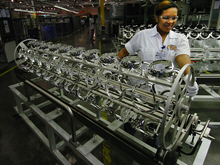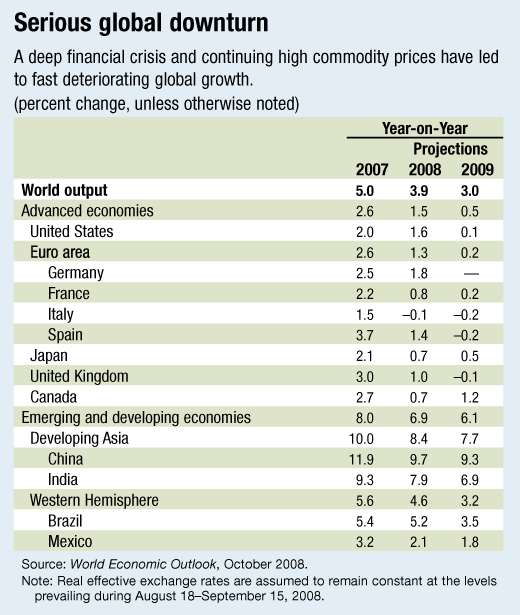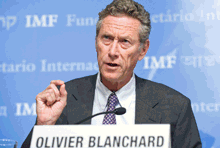
Typical street scene in Santa Ana, El Salvador. (Photo: iStock)
IMF Survey: IMF Predicts Major Global Slowdown Amid Financial Crisis
October 8, 2008
- World growth will slow amid most dangerous financial shock since 1930s
- No growth in many advanced economies until at least mid-2009
- Global economy expected to stage modest recovery later in 2009
The world economy is decelerating quickly—buffeted by an extraordinary financial shock and by still-high energy and commodity prices—and many advanced economies are close to or moving into recession, the IMF says in its latest World Economic Outlook (WEO).

Financial turmoil effects are spreading to firms that rode oil price hikes but now face sharply slowing demand (photo: Layne Bailey/Charlotte Observer)
WORLD ECONOMIC OUTLOOK
The October 2008 report, which was released two days prior to the IMF-World Bank Annual Meetings in Washington, said that growth in emerging economies is also weakening after years of strong growth, though it will still drive global growth.
Speaking at the WEO press conference, IMF Chief Economist Olivier Blanchard emphasized the importance of implementing joint financial and macroeconomic policies at this point "to stem the negative momentum on multiple fronts." On the financial side, "this implies the design of comprehensive programs to deal with systemic problems," while on the macroeconomic side, "this implies the use of monetary and fiscal policies to support growth and break negative feedback loops between the financial and real sectors," he said.
"With the right macro and financial policies—and these policies are available—we can ride the storm, and expect a recovery to start in the course of 2009," he added. He also welcomed the October 8 announcement by the U.S. Federal Reserve, the European Central Bank, and four other central banks to lower interest rates by a half percentage point. "It is a step in the right direction," he said.
Very gradual recovery
The world economy is entering a major downturn in the face of the most dangerous financial shock in mature financial markets since the 1930s, according to the WEO, which now expects world growth to slow to 3.0 percent in 2009—0.9 percentage point lower than forecast in the July 2008 WEO Update.
Following sluggish growth through the remainder of 2008 and early 2009, the anticipated recovery later in 2009 will be exceptionally gradual by past standards. This is because financial conditions are expected to remain very difficult, even assuming that actions by the U.S. and European authorities succeed in stabilizing financial conditions and in avoiding further systemic events.
"In advanced countries, the crisis is now being driven by a downward spiral of loss of confidence and trust," Blanchard said. The effects are spreading to consumers and firms, he warned, which had so far weathered the recent price hikes in oil and commodities well but were now experiencing sharply slowing demand.
However, despite the emerging economies' cooling momentum, they are still expected to provide a source of resilience, benefiting from strong productivity growth and improved policy frameworks. But the longer the financial crisis lasts, the more the emerging economies' growth is likely to be affected.
Inflation easing in advanced economies
In terms of inflation, the combination of rising economic slack and stabilizing commodity prices is expected to contain the pace of price increases in advanced economies. But in many emerging and developing economies, inflation is projected to remain elevated through the end of 2008 as recent commodity price increases continue to feed through to consumers, before easing somewhat by the end of 2009.
Despite the deceleration of global growth, headline inflation has risen around the world to the highest rates since the late 1990s, pushed up by the surge in fuel and food prices. In the advanced economies, 12-month headline inflation registered at 4¼ percent in August.2008, down modestly from a peak in July in the wake of some commodity price easing.
The resurgence in inflation has been more marked in the emerging and developing economies, with headline inflation reaching 8¼ percent in the aggregate in August and with a wide swath of countries now experiencing double-digit inflation.
Wage increases
To some extent, the difference reflects the considerably greater weight of food prices in consumption baskets in these economies—typically in the range of 30-45 percent, as opposed to 10-15 percent in the advanced economies. However, inflation—excluding food and fuel—has also accelerated markedly, and there are signs of rising inflation expectations and wage increases, although such data are not as systematically available as in the advanced economies.
The WEO notes that commodity prices remain at much higher levels in real terms than at any time in the past 20 years, despite some correction since mid-July amid the slowdown of the global economy. The driving force behind the sustained runup in commodity prices has been the tightness of demand-supply balances for many key products and the realization that markets are likely to remain tight for the foreseeable future, after many years of ample spare capacity.
Risks to baseline projections
The latest report sees the principal downside risk to growth from two related financial concerns: persistent financial stress and the credit constraints from deleveraging, which could be deeper and more protracted than in the baseline scenario; and the U.S. housing market deterioration, which could be deeper than forecast, while European housing markets could weaken more broadly than envisaged in the baseline.
As noted in the October 2008 Global Financial Stability Report released on October 7, a failure to restore confidence in the global financial system through internationally coherent and decisive policy measures could lead to an increasingly disorderly unwinding of leverage. This would, in turn, imply greater costs to the real economy than are built into the baseline projections of the WEO.
In this exceptionally uncertain situation, there are substantial downside risks to the baseline outlook. In addition to concerns related to protracted financial stress and the deteriorating U.S. housing market, potential disruptions to capital flows to emerging economies and the risks of rising protectionism represent additional risks to the recovery. Inflation risks to growth are, however, now more balanced because commodity prices have retreated in response to slowing global growth.
Prospects for a turnaround
The advanced economies grew at a collective annualized rate of only 1 percent from the fourth quarter of 2007 through the second quarter of 2008. The U.S. economy suffered the most from the financial crisis that originated in its subprime mortgage market, which has tightened credit conditions and amplified the housing correction that has been under way since 2006.
Emerging and developing economies have not decoupled from this downturn. The WEO notes that growth has also eased for this group of countries as a whole. Growth has been most resilient in commodity-exporting countries, while the countries with strong trade links to the United States and Europe are slowing markedly. Also, some countries that rely heavily on bank-related or portfolio inflows to finance large current account deficits have been hit hard by an abrupt tightening of external financing.
The baseline projections show the global economy undergoing a major downturn, with growth falling to its slowest pace since the 2001-02 recession. Although a gradual recovery is envisaged in late 2009, global growth is not expected to return to trend until 2010. The report sees the eventual recovery as being supported by the unwinding of adverse terms-of-trade effects as commodity prices stabilize; a turnaround in the U.S. housing market; and rising confidence that the liquidity and solvency problems in core financial institutions are being resolved.
On an annual basis, global growth is expected to moderate from 5.0 percent in 2007 to 3.9 percent in 2008 and 3.0 percent in 2009 (see table).

For the remainder of 2008 and early 2009, the U.S. economy faces flat to negative growth as support from the fiscal stimulus ebbs, export momentum moderates, and tight financial conditions take an increasing toll. An emerging turnaround in the housing sector and more stable oil prices should help lay the basis for incipient recovery in the second half of 2009, but the revival is expected to be much more gradual than in previous business cycles, as tight credit conditions continue to weigh heavily on domestic demand.
Most other advanced economies are also expected to go through a period of extremely sluggish growth or contraction in 2008 and the first half of 2009, and experience only a modest upturn in the latter part of the year.
Growth in emerging and developing economies is also projected to continue to decelerate, falling somewhat below trend during the second half of 2008 and early 2009, before picking up in the course of the year. During this period, overall growth in these countries is projected to remain well above rates experienced in the 2001-02 global downturn.
Export growth will continue to slow and domestic demand will also moderate, although demand will continue to be supported by the strong productivity gains made in recent years. Commodity-exporting countries—particularly oil exporters—are expected to maintain their momentum, but growth in countries dependent on food and fuel imports or external financing will slow quite sharply. Net external capital inflows are projected to fall by half in the aggregate, and some countries could face substantial pressure on reserve positions.
Policy challenges
The WEO underscores that policymakers around the world today face the imperative of stabilizing global financial markets, while nursing their economies through a global downturn and tight credit and ensuring that the recent rise in inflation is reversed.

IMF Chief Economist Blanchard: "With the right macro and financial policies—and these policies are available—we can ride the storm" (IMF photo)
Policymakers face the enormous challenge of dealing with the immediate threat to financial stability, while also paving the way for rebuilding a firm underpinning for financial intermediation. Achieving this daunting task will require comprehensive solutions that address the systemic problems—the proliferation of illiquid problem assets, the shortage of capital, and the collapse of counterparty confidence—while dealing rapidly and effectively with emerging problems in individual institutions.
Macroeconomic policymakers are seeking to find a balance between supporting activity in the face of a global downturn and extremely difficult financial conditions and ensuring that the sustained shift in relative prices implied by the surge in commodity prices does not drive a ratcheting-up of inflation, as occurred in the 1970s.
Commodity market strains
The appropriate policy stance will vary across countries. A turn to more supportive stances is justified in some economies now facing recession as a result of financial strains, housing downturns, and terms-of-trade losses. Nevertheless, policy tightening is still called for in a number of countries that are still growing well above their speed limits.
The recent decline in commodity prices in the face of a global slowdown should not be allowed to undercut policy efforts to relieve strains in commodity markets. The focus should be on policies to improve supply and demand responsiveness, while avoiding measures that could exacerbate market tightness in the short term.
Finally, it will be important to ensure that large imbalances in trade flows do not lead to a buildup in protectionist measures on either the current or capital account. Breaking the current deadlock on the Doha Round would help strengthen the open multilateral trading system.
Comments on this article should be sent to imfsurvey@imf.org







